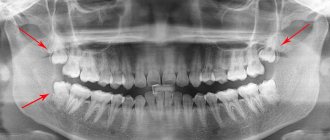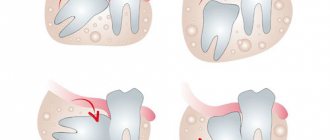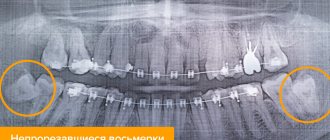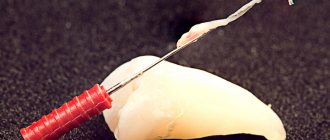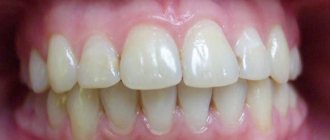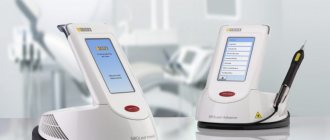Do we need wisdom teeth?
I use the only compound word. In biology there is such a concept as RUDIMENT
- a part of the human body that has lost its function in the process of evolution. The most famous rudiment is the vermiform appendix of the intestine or appendix. So - a large number of doctors and people believe that there is nothing superfluous in the body and wisdom teeth can serve a person at an older age, when the loss of basic teeth occurs and the doctor can use figure eights to install, for example, a bridge.
Unfortunately, in most cases this is impossible and even wrong!
Most people simply do not have room in the jaw for eighth teeth, and Mother Nature begins to mock them (and, naturally, us doctors) in every possible way: painful eruption, irregular shape, incorrect size of the tooth itself, poorly developed root system - all of the above leaves no chance for the correct use of “eights”.
How wisdom teeth are formed
Unlike other teeth, the rudiments of wisdom teeth are formed not during intrauterine development, but at 3–5 years, when the child’s body is preparing to replace milk teeth with permanent dentition. At this age, you can determine the number of future eights (and there can actually be from one to four). But at this age, it is not yet possible to detect any possible developmental pathologies.
It becomes more or less clear a little later, the crown part of the wisdom teeth begins to form. The formation process starts in a child at about 12 years of age, but the development of the root part of the figure eight takes several more years and can continue even after tooth eruption. Considering that the most common age for the appearance of wisdom teeth is 18–25 years, the eruption of eights occurs already in adulthood. It’s not for nothing that I said earlier the phrase “actually from one to four,” since approximately 10–15% have no eights at all. That is why it is normal to consider the number of teeth in an adult to be from 28 to 32. Those are wisdom teeth, right? How unwise they treat us and make puzzles!
Correct your bite or dental defect with invisible aligners Find out what it is
How to know if a wisdom tooth is coming out
A wisdom tooth or “eight” is a third molar that erupts on both sides of both jaws at 16-30 years of age.
Because this age is considered mature, and the third molar is the last one to grow in the jaw, it is called a “wisdom tooth.” Some dentists consider the “eight” to be a vestige, that is, an organ that has lost its significance in the course of evolution. Primitive man needed it to chew rough plant foods - nuts, grains and leaves.
Modern man eats soft food that has undergone culinary processing, so the jaw has become 10-12 cm smaller, and the dental system has been rebuilt. As a result, in 76% of people, the third molar does not erupt, remaining in the bone socket, or grows partially or incorrectly.
From the article on Stom-Firms.ru you will learn how a wisdom tooth grows, why it is difficult for it to erupt and what symptoms arise.
Cutting out wisdom teeth is a real headache
The “birth” of a wisdom tooth in the oral cavity is always painful. The main reasons for the painful effect are thick walls of the dental sac, thickened mucous membrane and reduced growth-forming factors. In addition to the painful process itself, teething can cause many other complications. Which ones? Let's talk about this in a little more detail.
The wisdom tooth sometimes does not erupt completely, crowding the surrounding teeth. This situation usually entails local inflammation and pain.
The time during which a wisdom tooth is cut can be quite long, and inflammation can constantly bother you, manifesting itself as an increased temperature of the whole body and sensitive pain, which sometimes makes it difficult to even just open your mouth! This condition is fraught with inflammation of the tissues surrounding the problematic tooth, right down to the bone, and therefore requires immediate intervention by a qualified dentist.
The first problem with teething eights is caries.
Often, while a wisdom tooth is growing, it is difficult to effectively clean it (due to the location of the wisdom teeth deep in the jaw). This is how caries occurs. Incorrect positioning of wisdom teeth during eruption also increases the risk of tooth decay on the adjacent tooth due to difficulty accessing the spaces between these teeth. If symptoms of caries appear, you must consult a dentist and carry out appropriate treatment. Very often in this case, it is recommended to remove the wisdom tooth, especially if all other teeth are developed normally.
In practice, it happens that a wisdom tooth erupts already... sick, that is, it becomes infected with caries while still in the gum. In such cases, the figure eight should be removed immediately so that the diseased wisdom tooth does not negatively affect the remaining teeth.
The second problem is a cyst
In rare cases, a cyst and tumor may develop in the tissues surrounding an erupting wisdom tooth, which requires immediate surgical intervention by a dental surgeon.
The third problem is malocclusion
If the position of a wisdom tooth is incorrect during eruption, there is a high probability that such a tooth will significantly affect the position of the remaining teeth, which causes a change in the bite. And aesthetic problems arise - the teeth begin to stand crooked in the mouth. And this entails orthodontic treatment, bringing the dentition in order.
The fourth problem is tongue dysfunction
In addition to aesthetic problems, this can also cause functional problems. For example, if a wisdom tooth is displaced towards the vestibule of the oral cavity, serious injury to the mucous membrane of the cheeks, lips or tongue can occur, causing the appearance of erosions and ulcers.
Fifth problem - the wisdom tooth wanted to erupt, but could not erupt
Rarely, a situation occurs when, due to a lack of space in the dentition or in the case of an incorrect inclination of the wisdom tooth itself, an anomaly develops, called a “submerged wisdom tooth.” Such “submerged” teeth are usually removed.
It is possible that the wisdom tooth does not erupt
at all. Despite its absence, such a tooth is dangerous due to its complications. It can damage the roots of neighboring teeth or provoke neuralgic pain. In this case, you need to contact a surgeon and, most likely, the figure eight will have to be removed.
The sixth problem is pericoronitis
At the moment of eruption of the lower (!) wisdom teeth, when only part of the tooth has appeared, acute inflammation and even accumulation of pus in the formed hood between the gum and tooth can occur. This causes a serious disease called pericoronitis (pericoronitis).
The main symptoms of the inflammatory process during pericoronitis are pain and swelling of the gums surrounding the wisdom tooth, bad breath and an unpleasant taste.
If these symptoms appear during the eruption of a wisdom tooth, you should urgently consult a dentist.
The seventh problem of wisdom teeth is periodontitis
When the figure eight erupts quite smoothly, due to its inconvenient location during brushing, the wisdom tooth is not properly cleaned of plaque. Removing tartar and plaque on this tooth in dentistry is also problematic. Because of this, bacteria begin to accumulate around the wisdom tooth, causing inflammation of the gums - periodontitis, which can then develop into osteoperiostitis. In this case, the tooth must be removed.
What to do with a bothersome wisdom tooth at home
The most important thing is not to cause further harm to yourself before visiting the dentist. It is extremely important to avoid overheating the area of concern. Heat can accelerate the onset of the inflammatory process. Therefore, you should not apply warm compresses or take a hot bath.
What can you do to relieve pain when wisdom teeth erupt:
- follow a gentle diet (do not eat very hard, hot or cold foods);
- after eating, rinse your mouth;
- use local anesthesia, such as gels used during teething in children;
- In case of severe pain, you can take painkillers.
But the most important thing is not to delay your visit to a specialist! Only he will be able to determine the seriousness of the problem and help avoid possible complications.
You can get a quality consultation on wisdom teeth in your city
I want to check my eights!
Treat or remove eights?
Now regarding orthodontic treatment and wisdom teeth. Believe me, it is very unpleasant for us doctors, as well as for patients, to make radical decisions. But there are good reasons! These are your own stories. Stories of patients who underwent treatment with braces as teenagers, achieved excellent results and...
All the beauty of straight teeth, especially the lower incisors (you just started to enjoy a beautiful smile) - it disappears at 20 and beyond. It is when most of us fully develop these “eights”. Two, three and even four years of therapeutic “torment” to correct crooked teeth, transform them into a beautiful/sweet/courageous smile, as they say, down the drain... Yes, yes - the only option to become the owner of beautiful teeth again is repeated orthodontic treatment. It doesn’t matter whether it’s aligners or braces again, the important thing is that there is a good saying: forewarned is forearmed! No one is immune from mistakes and relapse.
Our body is beautiful and magical in that it almost always adapts and compensates for almost any pathology. Therefore, the “eights” cut through with difficulty and subsequently deform
there are very important teeth in front!
When to ask for help
There are several signs that you need to see a dentist as soon as possible for an examination and help:
- Severe pain that covers the gums can radiate to the cheek. Sometimes its location becomes difficult to determine. There are cases when pain can also appear in the head, temples, throat, and ears.
- Increase in body temperature. Fever signals that the inflammatory process has begun. Usually the temperature does not rise too high, but it is enough for a person to feel weakened and personal productivity is significantly reduced.
- Inflammatory process. The gums become very swollen and red; with advanced inflammation, pus discharge and bad breath may appear.
Doctors also record an increase in the size of the lymph nodes. Some, due to pain, simply cannot open their mouths or chew food normally.
It is worth paying attention to the fact that slight pain during the eruption of wisdom teeth is normal. But even in this case, you should consult a dentist. He will take a picture and be able to understand whether the growth of the tooth poses any danger.
So what do we do with eights?
The moral of this story is this: trust qualified and educated doctors, not kind and humane “neighborly” advice. Be wise. Especially at such crucial moments in life, when wisdom teeth make themselves felt. And in general, I wonder who was the first to call them “wisdom teeth”?
Moreover, an interesting point from medical practice: if you (what if?) decide to remove the eights, it is not a fact that they will be removed for you. The reason is simple - wisdom teeth must be removed exactly according to indications. A normal doctor will never remove a healthy tooth just because you want it.
You have decided to remove your wisdom teeth. How traumatic is this?
If the wisdom tooth has grown normally, its roots are not intertwined, removal usually takes place without any complications. The edges of the tooth socket after extraction are often not even sutured.
What is most important after removing the figure eight is to allow the socket of the just removed wisdom tooth to heal. Quite a big wound.
What is absolutely impossible to do?
You should not rinse vigorously, even with such seemingly beneficial solutions as chamomile or calendula.
What needs to be done.
To get rid of food debris, you need to carefully take water into your mouth and do short oral baths without intensive rinsing. Instead of water, you can use a solution of chlorhexidine, miramistin or analogs specially sold in pharmacies - they disinfect the oral cavity. And so - for at least three days. If this recommendation is neglected, the hole may become inflamed. Then the dentist prescribes treatment with medications, including antibiotics.
What if the roots of an insidious wisdom tooth are intertwined or fused?
Unfortunately, in this case complications cannot be ruled out - soft tissues may be damaged. If an inflamed tooth is removed, in rare cases the neurovascular bundle (!) of the lower jaw is injured. In this case, separate treatment may be required.
Removal of abnormally growing eighth tooth
Very often, if the third molar grows abnormally, it is necessary to resort to its removal. Indications for surgery:
- Repeated cases of pericoronitis (purulent formation in the gum pocket). This problem most often occurs on the lower eights, which have not completely erupted. Pericoronitis is usually treated by removing the overhanging gum, but if the disease recurs, it is recommended to remove the offending tooth.
- The upper eight grows into the cheek, constantly injuring it. To avoid the formation of ulcers and infection of the oral cavity, as well as to prevent pain, wisdom tooth removal is required.
- The development of wisdom tooth dystopia was diagnosed. The tooth grows at an incorrect angle, which can lead to inflammation of the periodontal tissues and the development of caries on the eighth and neighboring teeth.
- The wisdom tooth grows to the side and affects the ternary nerve, causing attacks of pain. Most often, this occurs when an unerupted figure eight rests on the roots of neighboring teeth. Such an anomaly can only be diagnosed using an x-ray.
The procedure for performing the manipulation may differ depending on the location of the tooth. The sequence of the procedure during surgery:
- antiseptic treatment of the operating area;
- administration of anesthetic;
- tooth extraction;
- inserting a gauze swab into the hole to eliminate bleeding.
The tampon should be removed from the wound no earlier than after 25 minutes. The tampon must be in the socket to prevent bleeding. After the operation, the dental surgeon gives recommendations that must be strictly followed.
When is it advisable not to remove wisdom teeth?
There are situations when the “seventh” or “sixth” chewing teeth must be removed. And in this situation, a wisdom tooth that has grown correctly may still be useful. It will become one of two supports for the future bridge. However, in this case, a healthy sixth (or fifth) tooth will suffer, because it will have to be treated for an abutment crown.
Now a little about sad things
. 10-15 years will pass, the bridge will “work out” its required operating time. And sometimes it will no longer be possible to insert an implant - the atrophied jaw bone under the bridge will not allow it: in the absence of teeth, any person develops edentulous bone tissue. Thus, on the horizon of life there appear removable jaw dentures and newfangled gels that make them easier to wear.
Now a little about the positive
.
In such situations, you can initially consider dental implantation in specialized
medical centers, where they will help restore bone volume and take control of the dental situation.
Potential pathologies during the eruption of wisdom teeth
There are a large number of potential pathologies that accompany the appearance and growth of wisdom teeth. It is the risk of such pathologies that becomes the main reason for visiting a dentist. If this is not done, you may experience sepsis and severe inflammation.
Let's look at the most common pathologies.
Growing wisdom tooth to the side
There is a high probability that the tooth will grow towards the tongue or cheek. In this case, a dangerous situation is created when soft tissues are in a state of constant injury. This leads to inflammation.
At the same time, other teeth also shift. If the mechanical impact is not stopped, there is a potential risk of the formation of a malignant tumor. Often the only way out of the situation is removal, because modern methods do not allow the growth of a molar to be corrected.
The tooth grows towards the neighboring one
This is a very dangerous situation because there is a risk of gradual destruction of the crown. If too much damage is done, there is a chance that two adjacent teeth will have to be removed at once.
The pain in this position of the molar becomes very severe. At the same time, the person cannot find a place for himself, cannot eat and sleep normally.
Gum inflammation
The inflammatory process that affects the gums is medically called pericoronitis. It often begins when the tooth has already erupted.
Due to the great remoteness, problems often arise with regular hygiene and removal of accumulated plaque. The result is a gradual accumulation of bacteria.
The inflammatory process can quickly cover the entire jaw. The result will be the need for emergency surgery. Sometimes this leads to the removal of several teeth at once.
What do we do after removing the eights?
We evaluate the possible damage that figure eights could cause to neighboring teeth. If the adjacent teeth are deformed, then the pathology may spread like a domino effect, and here it is already necessary to carry out systemic orthodontic treatment aimed at correcting the disturbed bite.
The most gentle and aesthetic type of dental correction today is aligners. The site provides a lot of information on aligners, but I would like to mention one undeniable advantage, namely, the patient can see the result of his treatment with aligners without even starting it! How so, you ask? The answer is simple - all future treatment of the patient is calculated using modern computer technology. The example below shows a real clinical case, a patient with crowded teeth caused precisely by the pathological effect of “eights” on neighboring teeth.
Removal of a wisdom tooth near the maxillary sinus
If the wisdom tooth is located near the maxillary sinuses, there is a certain difficulty in such removal. Why?
If a wisdom tooth is located close to the maxillary sinus, there is a risk that during removal the tooth can be pushed into the maxillary sinus. If you make incorrect technical movements when removing a tooth, or work roughly in some way, you can harm the person and, accordingly, you will then need expensive long-term treatment to remove this tooth.
Let's see how wisdom teeth led to crowded teeth
And how crowded teeth are eliminated with Star Smile aligners
The video shows how the 3D setup is done. I am commenting on the video, orthodontist Alexander Spesivtsev, clinical director of Star Smile, a doctor with many years of experience in the successful use of aligners in orthodontic practice. To restore straight dentition, the wisdom teeth themselves—the eights—had to be removed. At Star Smile, or rather in the clinics of its partners (more than 70 cities in Russia), any treatment begins with diagnosis and drawing up a virtual setup. The doctor takes photographs of the patient’s face, dentition, as well as x-rays and dental casts. Using special software, the obtained data is processed and a three-dimensional model of the patient’s dental system is obtained. And this already allows you to calculate the trajectory of tooth movement, treatment time, and the required number of sets of aligners. Also, the final result of the treatment will be visualized - the patient will be able to evaluate the aesthetics of the smile after treatment. Patients really like this approach - they can see their future smile, their straight teeth. The forecast of a 3D setup when straightening teeth with aligners comes true in almost 100% of cases. You see, this is completely different from correcting a “blind” bite, as is usually the case with braces. Everything is clear here, without any guesswork or assumptions.
Gevorkyan Oscar Vladimirovich
Candidate of Medical Sciences, Oral and Maxillofacial Surgeon, Central Scientific Research Institute, Scientific Consultant Star Smile “ If you are faced with questions
:
- To remove or not to remove wisdom teeth?
- How dangerous is it to remove wisdom teeth?
- When do wisdom teeth interfere with orthodontic treatment?
- and most importantly, is it possible to avoid the removal of “eights”?
Feel free to contact the doctors at Star Smile, they will help you understand this sometimes complex, but very important life problem for many.
Do not delay the decision in order to avoid possible complications in the future.” Since the Star Smile company is represented in all federal districts, large and medium-sized cities of Russia and interacts with many clinics and orthodontists, we offer you the opportunity to undergo a free consultation with high-quality orthodontists in your city , where you can discuss the problem of wisdom teeth and determine the optimal solution for you. To do this, you need to fill out the form below, a Star Smile medical specialist will contact you and help you by scheduling a consultation at a convenient time or providing your doctor’s contact information.
Don’t put off the problem of wisdom teeth “for later”!
What to do if a wisdom tooth begins to erupt
We looked at how to understand that a wisdom tooth is coming out, and what pathologies this process can cause. But what to do when the process has begun and you feel discomfort? There are several basic recommendations:
- Taking painkillers. Medicines such as Nurofen and Ibuprofen are often used. They help reduce inflammation and relieve pain in a short time. But you should not abuse such remedies, because as a result you will simply relieve unpleasant symptoms. There is a risk of developing dangerous pathologies.
- Contact your doctor. You should definitely visit a dentist who will conduct a detailed examination, take a photo of your tooth, and check how it is growing. Based on the information received, a decision on further treatment will be made.
- Delete. Unfortunately, in many situations, molar removal becomes the only treatment option. In this case, this is the only way to preserve the adjacent teeth and prevent severe inflammation.
A timely visit to the dentist, development of the correct direction of treatment - all this helps to solve the problem with the growth of wisdom teeth. If you are worried about pain, there are signs of inflammation, or you want to check the current condition of your teeth, make an appointment with us by phone or through the website.
Complications after wisdom tooth removal
What may be the cause of complications after removal of figure eights?
Complications after removing the figure eight - yes, they exist. Complications are different: they occur directly during the removal procedure, there are delayed ones, blood vessels may be damaged, and bleeding may occur. There may be a fracture of the jaw, a breakage of a section of bone tissue that is located in close proximity to the wisdom tooth.
Long-term complications – for example, wound infection in the case of unsterile instruments. If the doctor did not warn the patient that he needs to take antibiotics prophylactically for an impacted wisdom tooth.
What are the complications after wisdom tooth removal?
After the removal of a wisdom tooth, there are complications of different etiologies: they can either arise immediately or be delayed. Bleeding may immediately occur, your jaw may break, a piece of bone may break off (both small and large) - then your jaw will begin to hurt. You can tear the mucous membrane, injure a neighboring tooth, break a neighboring tooth, etc. Your gums or throat may begin to hurt.
Delayed complications are oral infection, periostitis, alveolitis, inflammation of bone tissue.
Can the temperature rise after wisdom tooth removal?
After the removal of a wisdom tooth, the temperature may rise in people who are very nervous or have suffered a lot of stress. This will be a vegetative-vascular reaction, and once the temperature can rise to 38.5-39 degrees. Once. It can be brought down by the use of antipyretic drugs and, accordingly, it should no longer be present. There may be a low-grade fever of 37 degrees, 37.1-37.2, for several days after removal. This does not have any consequences, this is normal, but you should, of course, inform the doctor about this so that he takes this fact into account and adjusts his prescriptions.
Can gumboil appear after wisdom tooth removal?
After wisdom tooth removal, gumboil may appear. This can happen as a result of a wound becoming infected. For example, the use of non-sterile instruments, non-sterile materials. This can also be a result of the removal of an impacted wisdom tooth, for example, if the doctor “sutured it in tightly”, and there are a lot of bacteria in our oral cavity, and did not prescribe antibiotic prophylaxis. In this case, flux is likely to occur.
At what age do wisdom teeth appear?
The growth of “eights” begins after 17 years. It is at this age that the crown of the last molar is finally formed, and their roots begin to actively grow. This process can begin a little earlier - at 14-15 years. Also in dentistry, cases have been recorded when a wisdom tooth began to grow at the age of 20-30. The record for the time of eruption of the third molar was set by a man whose teeth erupted at an advanced age - at 94 years of age.
The time of appearance of third molars varies from person to person. Each of the 4 teeth appears independently of each other. The first “eight” may appear at a young age, and the last one - in pre-retirement. It is also possible that wisdom teeth will be bothered by the discomfort characteristic of teething, but will not appear above the surface of the gums.
We know how to treat eights
Dry socket syndrome during wisdom teeth removal
Dry socket syndrome in wisdom teeth
The wisdom tooth refers to the concept of dry socket, or more precisely, dry socket syndrome. A dry tooth socket is alveolitis. Dry socket syndrome after the removal of figure eights can occur in this area, especially in the area of the lower wisdom teeth due to the fact that as a result of swallowing, as a result of opening the mouth, muscles tense, which aggravate the occurrence of alveolitis.
What can dry socket syndrome lead to and what to do?
A dry socket after the removal of figure eights can lead to very severe pain that radiates to the temple and ear. This is a very great torment: a person cannot, even if he is not sensitive, he cannot tolerate it, he will definitely take painkillers 4-5 or 6 tablets. And as a result of this, he will still go to the dentist. A dry socket, if it has formed after removal, will not go away on its own. Alveolitis can only get worse - up to inflammation of the jaw. There may be dire consequences.
